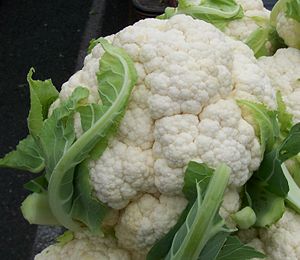Cauliflower: Difference between revisions
Jump to navigation
Jump to search

imported>Petréa Mitchell (Written by me, various sources) |
mNo edit summary |
||
| (One intermediate revision by one other user not shown) | |||
| Line 1: | Line 1: | ||
{{subpages}} | {{subpages}} | ||
{{Image|CauliflowerMadeleines.jpg|right|300px|A cauliflower head or "curd".}} | |||
'''Cauliflower''' is a variety of ''[[Brassica oleracea]]'' where the florets pack tightly into a white head called a ''curd''. | '''Cauliflower''' is a variety of ''[[Brassica oleracea]]'' where the florets pack tightly into a white head called a ''curd''. | ||
| Line 7: | Line 6: | ||
Cauliflowers require full sun and a climate where they can be exposed to low temperatures to trigger curd formation. In very hot climates, they will grow but only produce leaves. | Cauliflowers require full sun and a climate where they can be exposed to low temperatures to trigger curd formation. In very hot climates, they will grow but only produce leaves. | ||
For eating, the curd is broken up and can be eaten raw, in [[salad]]s or with [[dip]]s, or boiled, steamed, or [[pickling|pickled]] to make a vegetable accompaniment to meats. | For eating, the curd is broken up and can be eaten raw, in [[salad]]s or with [[dip]]s, or boiled, steamed, or [[pickling|pickled]] to make a vegetable accompaniment to meats.[[Category:Suggestion Bot Tag]] | ||
Latest revision as of 16:01, 25 July 2024
Cauliflower is a variety of Brassica oleracea where the florets pack tightly into a white head called a curd.
Cauliflowers require full sun and a climate where they can be exposed to low temperatures to trigger curd formation. In very hot climates, they will grow but only produce leaves.
For eating, the curd is broken up and can be eaten raw, in salads or with dips, or boiled, steamed, or pickled to make a vegetable accompaniment to meats.
